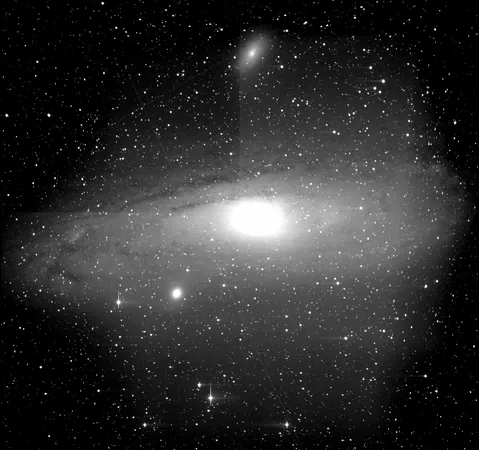
Stunning Snapshot of Andromeda: One Trillion Stars Captured in a Single Image!
2025-06-08
Author: Emily
A Galactic Marvel Unveiled
The European Space Agency has electrified the astronomical community with an astonishing image of Andromeda, our Milky Way's nearest spiral galaxy. Captured by ESA's Flyeye telescope during its inaugural imaging session in May 2025, this snapshot is not just technical genius; it showcases the telescope's phenomenal capabilities.
Andromeda in One Glorious Frame
The breathtaking image was created from 16 simultaneous 30-second exposures, ingeniously stitched together to encapsulate the entire Andromeda Galaxy in one frame. In a feat of efficiency, this drastically contrasts the NASA/ESA Hubble Space Telescope, which needed over ten years and 600 individual snapshots to portray the same galaxy.
The Power of Flyeye
Designed for rapid celestial surveys, the Flyeye telescope takes its cue from the compound eyes of insects, allowing it to scan vast expanses of sky in a blink. While primarily focused on planetary defense by tracking near-Earth objects, this remarkable instrument has emerged as a potent player in the realm of wide-field astrophotography.
Expanding Our Cosmic Vision
Once the entire network of Flyeye telescopes is operational, ESA will be capable of monitoring two-thirds of the visible sky up to three times a night. This leap in observational power will revolutionize our ability to detect moving celestial objects and transient phenomena, offering unprecedented insights into the cosmos.
Discovering Andromeda
Located 2.5 million light-years from Earth in the constellation of the same name, Andromeda is the furthest celestial object visible to the naked eye. Spanning over 220,000 light-years, it holds an astounding one trillion stars—more than a mere triple the star count of our galaxy.
A Cosmic Collision Course
Andromeda is on a slow, inevitable collision course with the Milky Way, with astronomers estimating a merger in about 4 billion years. But fear not—this cosmic dance poses no threat to individual stars or planets due to the vast distances between them. Instead, it will gently reshape both galaxies over billions of years.
The Importance of Andromeda
Visually, Andromeda appears as a faint cloud in the Northern Hemisphere's autumn skies, but through binoculars or small telescopes, its detailed structure emerges, revealing satellite galaxies like M32 and M110. As a prominent member of the Local Group—a cluster of about 80 galaxies—Andromeda is crucial for comprehending galactic formation and evolution.
A Subject of Endless Inquiry
Extensively studied across multiple wavelengths, Andromeda unveils secrets of its stars, dust, and even a huge halo of hot gas. This ongoing research not only enriches our understanding of galactic formations but also offers a sneak peek into how our Milky Way might evolve when it eventually merges with Andromeda.
Look to the Skies!
As a gateway to observing the broader universe, Andromeda remains a captivating target for both scientists and casual skywatchers alike, revealing insights into our cosmic neighborhood and the future of our galactic interactions.









 Brasil (PT)
Brasil (PT)
 Canada (EN)
Canada (EN)
 Chile (ES)
Chile (ES)
 Česko (CS)
Česko (CS)
 대한민국 (KO)
대한민국 (KO)
 España (ES)
España (ES)
 France (FR)
France (FR)
 Hong Kong (EN)
Hong Kong (EN)
 Italia (IT)
Italia (IT)
 日本 (JA)
日本 (JA)
 Magyarország (HU)
Magyarország (HU)
 Norge (NO)
Norge (NO)
 Polska (PL)
Polska (PL)
 Schweiz (DE)
Schweiz (DE)
 Singapore (EN)
Singapore (EN)
 Sverige (SV)
Sverige (SV)
 Suomi (FI)
Suomi (FI)
 Türkiye (TR)
Türkiye (TR)
 الإمارات العربية المتحدة (AR)
الإمارات العربية المتحدة (AR)